Vocabulary
Rope has been around for a while, from sailing to bondage with a detour via macrame, this creates a huge legacy on the vocabulary. The more foundational concepts tend to have acquired many names, and sometimes the same word can have different meanings from one community to another. For the sake of simplicity, we try to stick to one term per concept while mentioning alternate names. Which one was chosen is often a subjective choice and is a reflection of the period of time these texts were written. Language is fluid and continues to evolve.
Looking for more words? Use the search feature of the website to find references or check other glossaries listed at the bottom! Language is in constant evolution, if you’d like to see more words or add to a definition, put a note in the comments!
Essentials
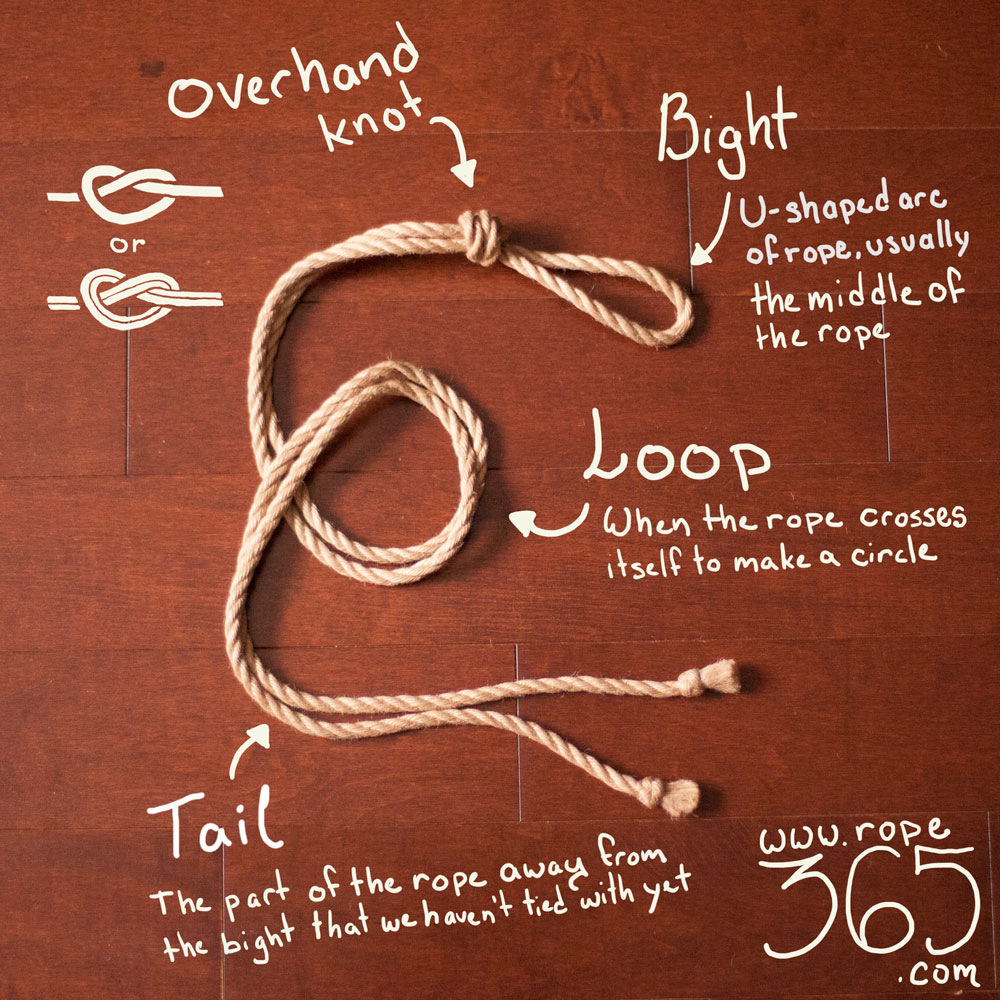
- Bight – U-shaped arc of rope, usually the middle
- Tail – The part of the rope away from the bight that we haven’t tied with yet
- Loop – When the rope crosses itself to make a circle
- Overhand knot – Simple stopper knot made by passing the one end of the rope through a loop
These are the only words you truly need to navigate Rope365! Feel free to skip ahead to Spring to get started with tying.
Bondage Techniques
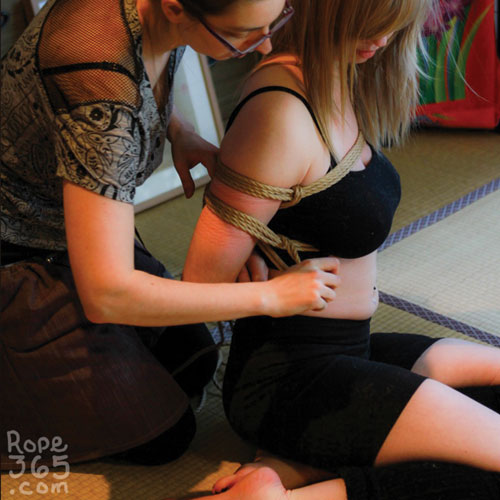 Shibari 縛り – A conjugation of the verb Shibaru “to tie” in Japanese. Generally refers to erotic Japanese rope bondage when used in English. Shibari 縛り – A conjugation of the verb Shibaru “to tie” in Japanese. Generally refers to erotic Japanese rope bondage when used in English. |
 Kinbaku 緊縛 – Literally “tight binding” in Japanese, and refers to erotic rope bondage in Japanese. It is generally considered as a synonym of shibari when used in English. Kinbaku 緊縛 – Literally “tight binding” in Japanese, and refers to erotic rope bondage in Japanese. It is generally considered as a synonym of shibari when used in English. |
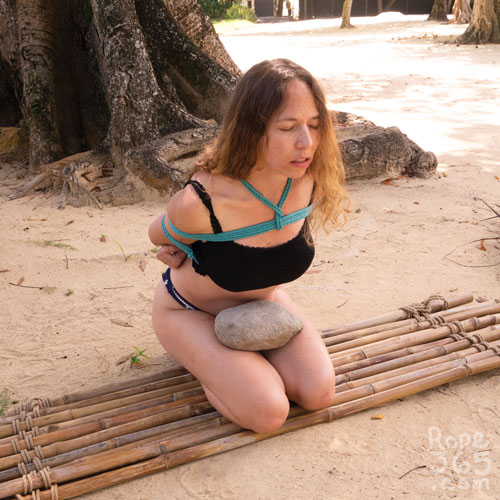 Torment rope aka semenawa 責め縄 – To create intense sensations with rope, usually with pain, usually in a progressive way. See Torture Torment rope aka semenawa 責め縄 – To create intense sensations with rope, usually with pain, usually in a progressive way. See Torture |
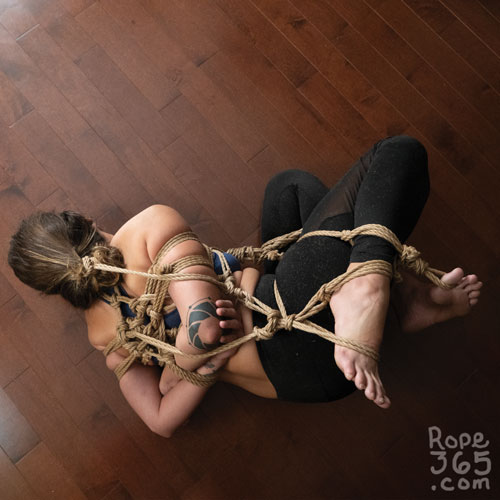 Predicament – A situation in which the different options will yield a negative outcome. In bondage, used to describe a tie where the person who is tied has agency, but only between painful, difficult or “bad” options. See Predicaments Predicament – A situation in which the different options will yield a negative outcome. In bondage, used to describe a tie where the person who is tied has agency, but only between painful, difficult or “bad” options. See Predicaments |
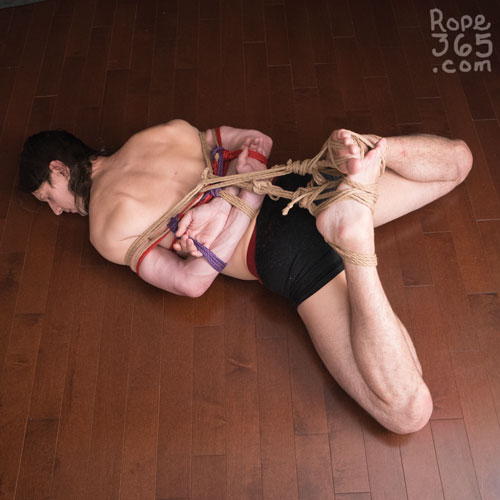 Floorwork aka newaza 寝技 – Method of tying that is done on the floor (or other surfaces such as a bed) that do not require an overhead suspension structure. Floorwork aka newaza 寝技 – Method of tying that is done on the floor (or other surfaces such as a bed) that do not require an overhead suspension structure. |
 Suspension, aka tsuri 吊り– Method of tying that uses an overhead structure in order to lift the person up. When the person tied is still in contact with the floor, it is referred to as partial suspension, aka Han-dzuri 半吊り. Suspension, aka tsuri 吊り– Method of tying that uses an overhead structure in order to lift the person up. When the person tied is still in contact with the floor, it is referred to as partial suspension, aka Han-dzuri 半吊り. |
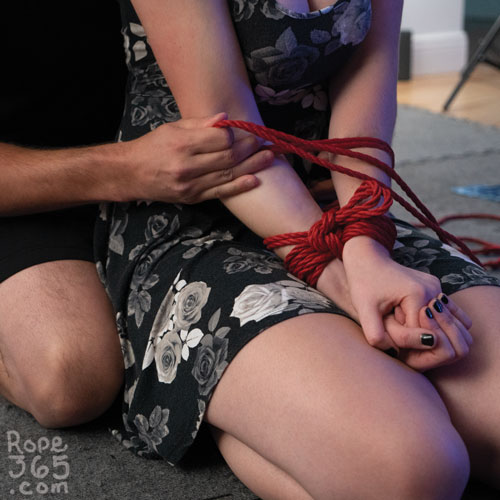 Ichinawa 一縄 (best rope), Ipponnawa 一本縄 (one rope) – Tying with one rope. Usually refers to tying in a sensual way although it can be used in other ways. See Improvisation Ichinawa 一縄 (best rope), Ipponnawa 一本縄 (one rope) – Tying with one rope. Usually refers to tying in a sensual way although it can be used in other ways. See Improvisation |
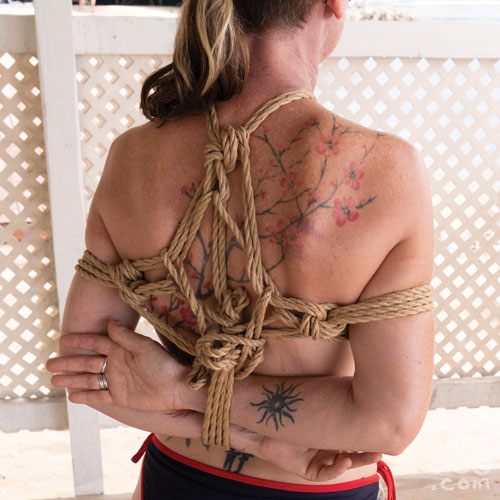 Hojōjutsu 捕縄術, aka Torinawa jutsu 捕縄術 – A traditional Japanese martial art of restraining a person using ropes. See Prisonner Ties Hojōjutsu 捕縄術, aka Torinawa jutsu 捕縄術 – A traditional Japanese martial art of restraining a person using ropes. See Prisonner Ties |
 Pillar tie aka Hashira 柱 – Tying someone to a vertical post Pillar tie aka Hashira 柱 – Tying someone to a vertical post |
People, Roles and Community
|
Top – Someone doing something to someone else, often used for the person tying.
|
|
Bottom – Someone receiving something from someone else, often used for the person being tied.
|
|
Switch – Someone who can play both roles, to top or to bottom.
|
|
Self-Tyer – Someone who ties themselves
|
|
Rigger – Someone who ties, also used in other fields like circus, animation and the nautical world where it has a strong sense of rope, knots and suspension.
|
|
Bunny, rope bunny – Someone that likes to get tied up. Contentious word as it is considered to be a reference to the Playboy bunny.
|
|
Nawashi 縄師, Bakushi 縛師, Kinbakushi 脇晒し – A person who ties with proficiency. Generally used for professionals.
|
|
Munch – A social activity for kinky people in a vanilla (non-kinky) setting.
|
|
Rope Class – Class to learn about rope, can be in-person or online.
|
|
Rope Intensive – Class to learn about rope that last for a full day or more. Usually in-person.
|
|
Rope Conference or Rope Con – A conference where several presenters are gathered to teach rope classes.
|
Rope Terminology
 Bight – U-shaped arc of rope, usually refers to the middle of a rope folded in half. Bight – U-shaped arc of rope, usually refers to the middle of a rope folded in half. |
 Tail, aka nawajiri 縄尻, standing end, working end, running end – The part of the rope that we haven’t tied with yet. Note that in the knot world, working end and running end refers to the short end that we are tying with, while the standing end is the long end. Tail, aka nawajiri 縄尻, standing end, working end, running end – The part of the rope that we haven’t tied with yet. Note that in the knot world, working end and running end refers to the short end that we are tying with, while the standing end is the long end. |
 Loop aka wakka 輪っか – When the rope crosses itself to make a circle. Loop aka wakka 輪っか – When the rope crosses itself to make a circle. |
 Frictions – The action of rope wrapping around rope creating a structure. See Frictions. Frictions – The action of rope wrapping around rope creating a structure. See Frictions. |
 Hitches – Knots used to bind a rope to an object or another rope. See Hitches and More Hitches. Hitches – Knots used to bind a rope to an object or another rope. See Hitches and More Hitches. |
 Half hitch – A simple loop around another object and secured to its own standing part. See Half hitch. Half hitch – A simple loop around another object and secured to its own standing part. See Half hitch. |
 Crossing hitch, aka nodome の止め, Munter hitch – A type of friction that holds two ropes crossing in place. It is often called Munter hitch, which is a similar belay technique in climbing. See Crossing Hitch, Reverse Crossing Hitch and More Hitches. Crossing hitch, aka nodome の止め, Munter hitch – A type of friction that holds two ropes crossing in place. It is often called Munter hitch, which is a similar belay technique in climbing. See Crossing Hitch, Reverse Crossing Hitch and More Hitches. |
 Clove hitch – A locking hitch created with two consecutive half hitches in the same direction. See The Lock and Clove hitch. Clove hitch – A locking hitch created with two consecutive half hitches in the same direction. See The Lock and Clove hitch. |
 Cow hitch aka Lark’s head – A hitch created with two consecutive half hitches in opposite directions. Various names are used depending on how the hitch is tied (ex: ring hitch, girth hitch, lanyard hitch etc.) See Extending Rope, Cow hitch. Cow hitch aka Lark’s head – A hitch created with two consecutive half hitches in opposite directions. Various names are used depending on how the hitch is tied (ex: ring hitch, girth hitch, lanyard hitch etc.) See Extending Rope, Cow hitch. |
 Inline Cuff aka Hojo cuff – Creating a cuff with the middle of the rope, usually with a half hitch around two wraps of rope. See Inline Cuff and More Hitches. Inline Cuff aka Hojo cuff – Creating a cuff with the middle of the rope, usually with a half hitch around two wraps of rope. See Inline Cuff and More Hitches. |
 Cinch, aka kannuki 閂 – When the rope goes between two columns and catches a rope on the other side. See Cinches. Cinch, aka kannuki 閂 – When the rope goes between two columns and catches a rope on the other side. See Cinches. |
 Quick release or Yuki knot – A knot that is released without having to untie either ends. The variation based on a captured slipped half hitch is often called Yuki knot in the honour of Yukimura Haruki (1948-2016). See Quick Release and More Hitches. Quick release or Yuki knot – A knot that is released without having to untie either ends. The variation based on a captured slipped half hitch is often called Yuki knot in the honour of Yukimura Haruki (1948-2016). See Quick Release and More Hitches. |
 Weaving – A technique to create a flat surface by alternating going over and under when lines cross perpendicularly. See Weavings and More Techniques. Weaving – A technique to create a flat surface by alternating going over and under when lines cross perpendicularly. See Weavings and More Techniques. |
Name of Ties
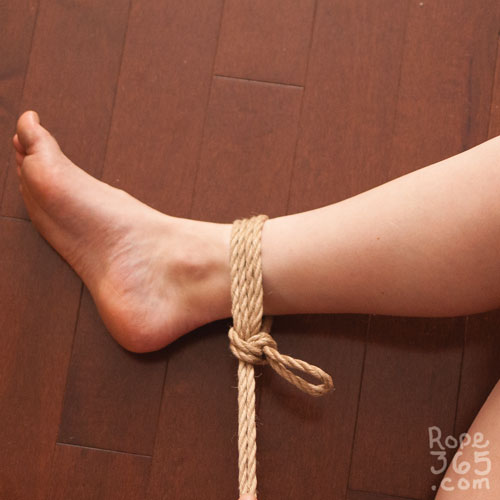 Single column tie – A cuff held in place by a knot so it will not tighten used to tie around something, usually a limb. See Single Column Tie and More Single Column Ties. Single column tie – A cuff held in place by a knot so it will not tighten used to tie around something, usually a limb. See Single Column Tie and More Single Column Ties. |
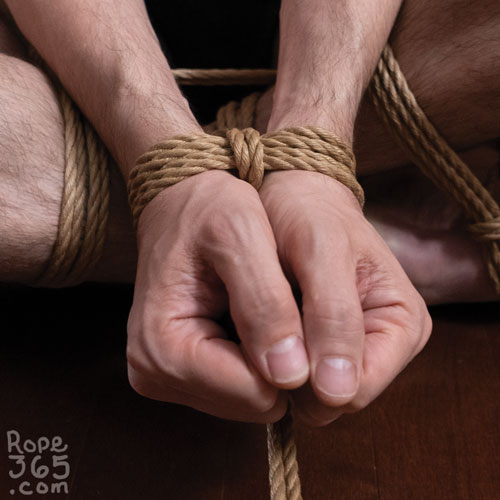 Double column tie – A cuff with a cinch that ties two columns together. See Cinches and More Column Ties. Double column tie – A cuff with a cinch that ties two columns together. See Cinches and More Column Ties. |
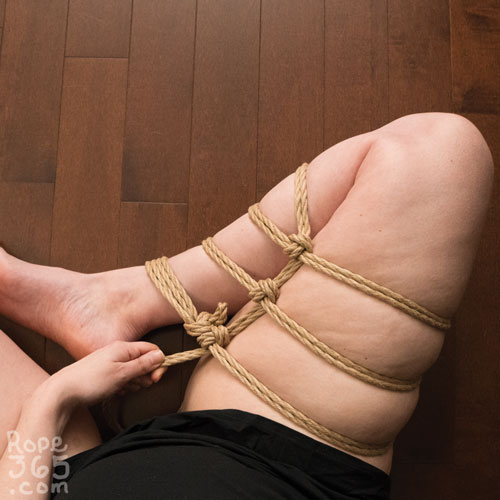 Frog tie, aka futomomo shibari 太腿縛り – A tie that holds a leg folded by tying the calf and the thigh together. See Frog Ties. Frog tie, aka futomomo shibari 太腿縛り – A tie that holds a leg folded by tying the calf and the thigh together. See Frog Ties. |
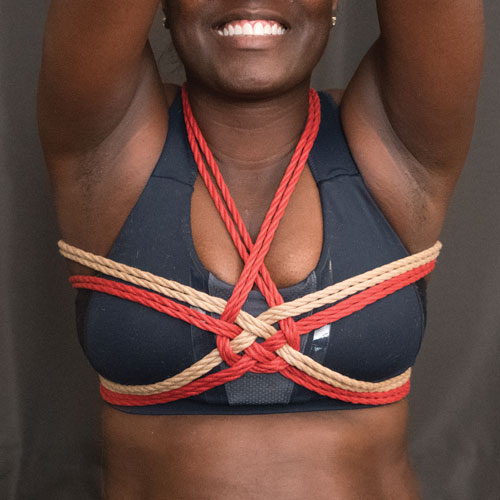 Chest harness, aka shinju 真珠 (pearl), munenawa 胸縄 (chest rope) – A tie on the chest without binding the arms. See Chest. Chest harness, aka shinju 真珠 (pearl), munenawa 胸縄 (chest rope) – A tie on the chest without binding the arms. See Chest. |
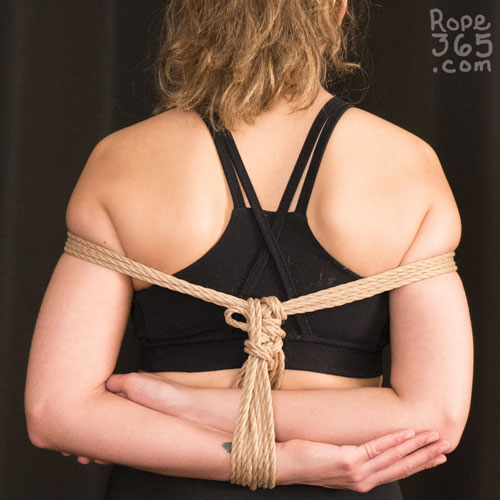 Box tie, aka ushiro takate kote shibari 後ろ高手 小手縛り (tie with the hands high in the back), gote shibari 後手縛り (tie with the hands in the back), munenawa 胸縄 (chest rope), TK (short for Takate Kote) – A classic tie with the hands in the back. See Box Ties and Box Tie Variations. Box tie, aka ushiro takate kote shibari 後ろ高手 小手縛り (tie with the hands high in the back), gote shibari 後手縛り (tie with the hands in the back), munenawa 胸縄 (chest rope), TK (short for Takate Kote) – A classic tie with the hands in the back. See Box Ties and Box Tie Variations. |
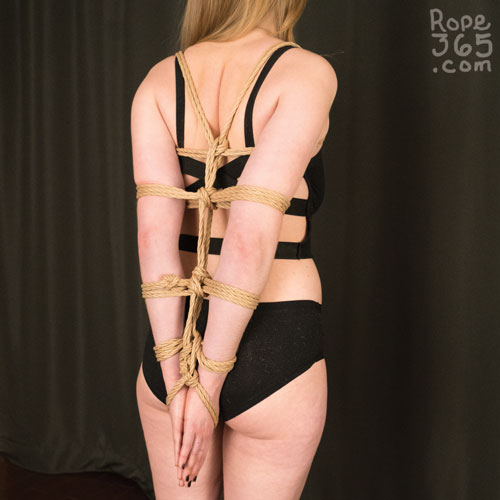 Strappado aka arm binder – A tie with both arms tied together parallel in the back. Arm binder is a more generic term and some will also include the arms tied parallel in the front in its definition. Some will argue that “strappado” specifically refers to a variation where the arms are pulled away from the body like in the medieval torture of the same name. See Hands behind the back. Strappado aka arm binder – A tie with both arms tied together parallel in the back. Arm binder is a more generic term and some will also include the arms tied parallel in the front in its definition. Some will argue that “strappado” specifically refers to a variation where the arms are pulled away from the body like in the medieval torture of the same name. See Hands behind the back. |
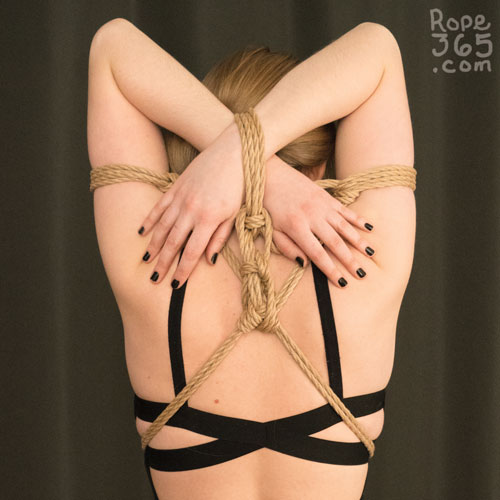 Bunny ears, aka waki zarashi 脇晒し (exposed armpit), pillow tie – A tie with the wrists behind the head and both elbows pointing up. See Frog Ties Assembling Ties and Hands behind the back. Bunny ears, aka waki zarashi 脇晒し (exposed armpit), pillow tie – A tie with the wrists behind the head and both elbows pointing up. See Frog Ties Assembling Ties and Hands behind the back. |
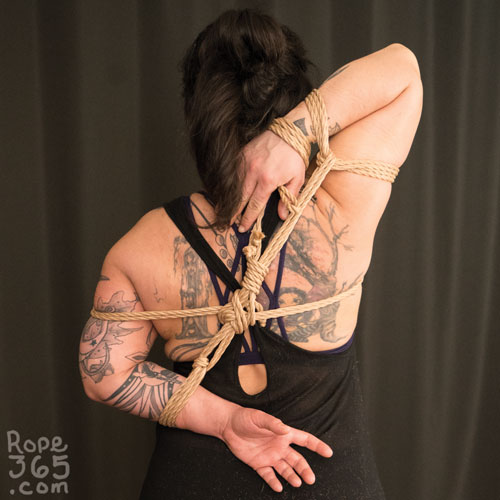 Riffle tie, aka teppo shibari 鉄砲縛り – An asymmetric tie with one elbow pointing up and the other arm behind the back. See Frog Ties Assembling Ties and Asymmetric Arms. Riffle tie, aka teppo shibari 鉄砲縛り – An asymmetric tie with one elbow pointing up and the other arm behind the back. See Frog Ties Assembling Ties and Asymmetric Arms. |
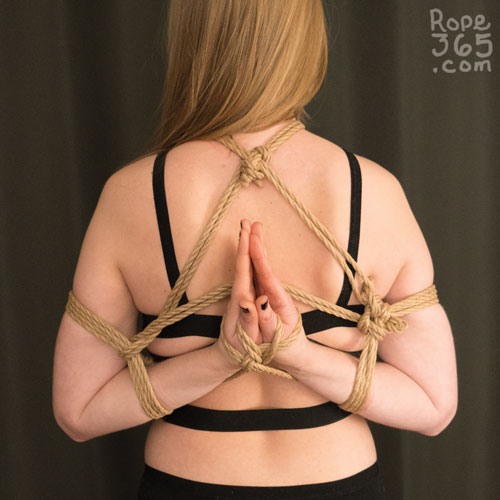 Reverse prayer tie, aka ushirote kannon shibari 後手観音縛り (Back kannon tie) – A tie with the palm together in the back pointing up. There are also variations with the hands in front. See Hands in the Back. Reverse prayer tie, aka ushirote kannon shibari 後手観音縛り (Back kannon tie) – A tie with the palm together in the back pointing up. There are also variations with the hands in front. See Hands in the Back. |
 Demon tie, aka tengu shibari 天狗縛り– A tie with the two wrists on each sides of the shoulders with the elbows pointing down. When the hands are flopping to the front, is often called T-Rex, and when the elbows are pulled further back, is referred to as Angel pose or Tenshi. See Frog Ties Assembling Ties and Elbow Ties. Demon tie, aka tengu shibari 天狗縛り– A tie with the two wrists on each sides of the shoulders with the elbows pointing down. When the hands are flopping to the front, is often called T-Rex, and when the elbows are pulled further back, is referred to as Angel pose or Tenshi. See Frog Ties Assembling Ties and Elbow Ties. |
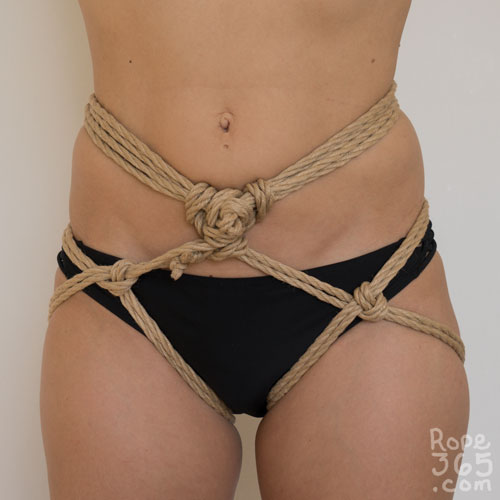 Hip Harness, aka koshi-nawa 腰縄 – A structure around the hips. See Hips and Butts. Hip Harness, aka koshi-nawa 腰縄 – A structure around the hips. See Hips and Butts. |
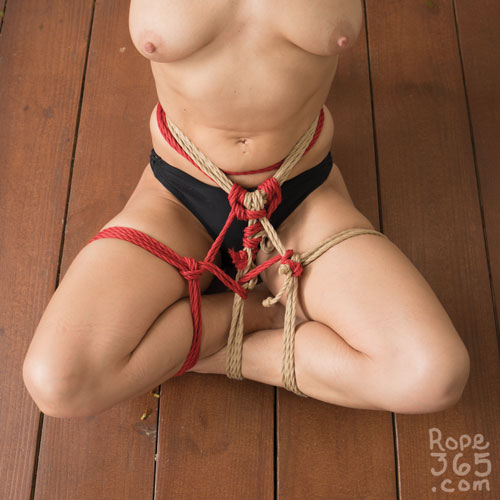 Cross-legged pose, aka agura shibari 胡座縛り – A structure tied on the leg crossed. See The Lock and Lower Body Structures. Cross-legged pose, aka agura shibari 胡座縛り – A structure tied on the leg crossed. See The Lock and Lower Body Structures. |
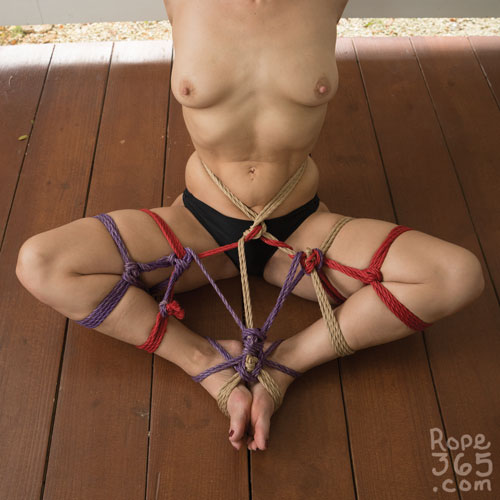 Butterfly pose aka bound angle pose, throne pose, cobbler’s pose, or ashiura awase shibari 足裏合わせ縛り (tie with the soles together) – Position with the soles of the feet against each other. See Lower Body Structure. Butterfly pose aka bound angle pose, throne pose, cobbler’s pose, or ashiura awase shibari 足裏合わせ縛り (tie with the soles together) – Position with the soles of the feet against each other. See Lower Body Structure. |
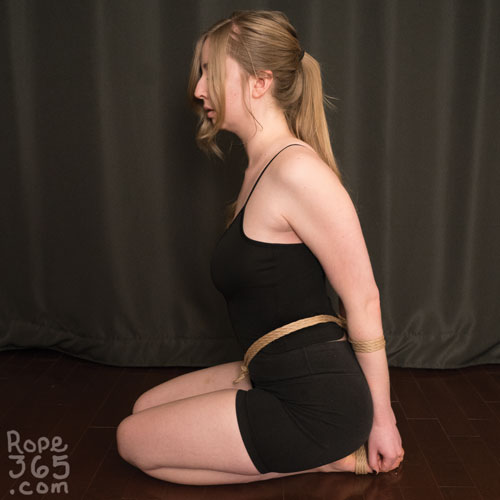 Seiza 正座 – Traditional way of sitting in Japan, kneeling, sitting on the feet. See Sitting and Kneeling. Seiza 正座 – Traditional way of sitting in Japan, kneeling, sitting on the feet. See Sitting and Kneeling. |
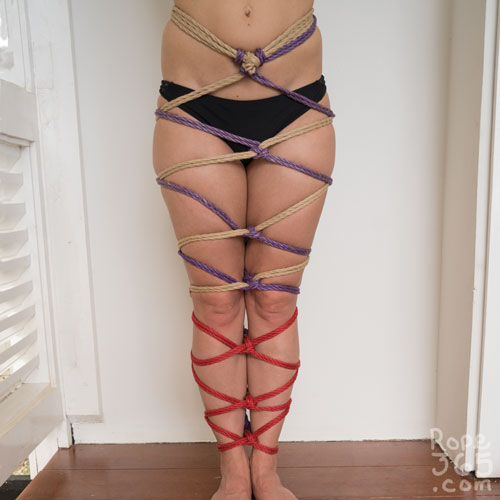 Mermaid – Legs tied together in a parallel way. When tied from the waist to the knee, it is referred as half mermaid or rope skirt. See Cinches and Lower Body Structure. Mermaid – Legs tied together in a parallel way. When tied from the waist to the knee, it is referred as half mermaid or rope skirt. See Cinches and Lower Body Structure. |
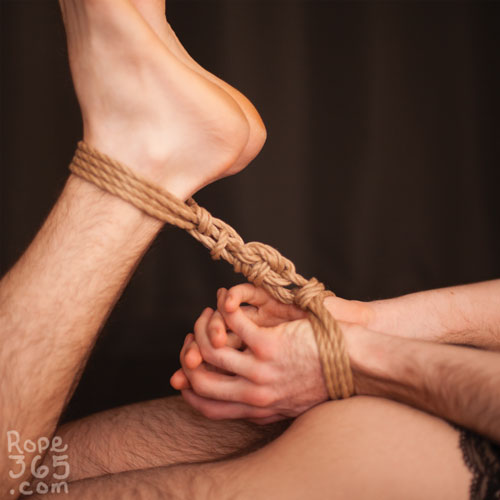 Hogtie, aka gyaku ebi shibari 逆海老縛 (reverse shrimp tie) – A tie with the ankles and the wrists tied in the back. See Hog Ties. Hogtie, aka gyaku ebi shibari 逆海老縛 (reverse shrimp tie) – A tie with the ankles and the wrists tied in the back. See Hog Ties. |
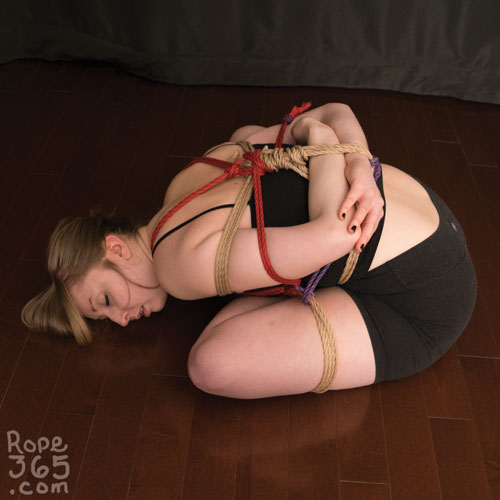 Shrimp tie, aka ebi shibari 海老繰り, ebizeme 海老責め – A tie with the ankles tied to the neck or chest to bend the person forward. It was one of the four torture techniques from the Edo period. See Quick release and Restrained. Shrimp tie, aka ebi shibari 海老繰り, ebizeme 海老責め – A tie with the ankles tied to the neck or chest to bend the person forward. It was one of the four torture techniques from the Edo period. See Quick release and Restrained. |
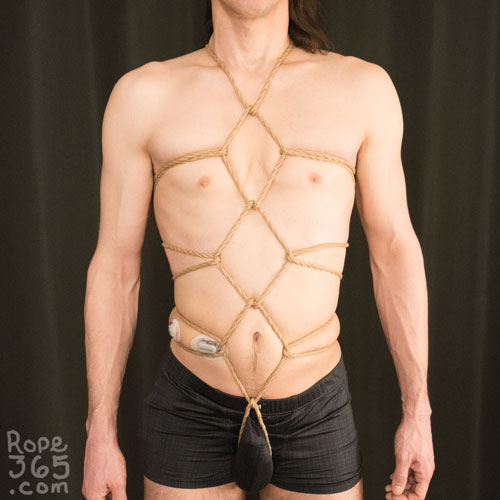 Diamond pattern, aka Hishi 菱 – A tie that creates lozenge shapes on the body. Karada 体 (body) is a common name for open diamond chest harness. Kikkou 亀甲 (turtle shell) is also used for variations with hexagons. See Chest Diamond, Frog Tie Diamonds. Diamond pattern, aka Hishi 菱 – A tie that creates lozenge shapes on the body. Karada 体 (body) is a common name for open diamond chest harness. Kikkou 亀甲 (turtle shell) is also used for variations with hexagons. See Chest Diamond, Frog Tie Diamonds. |
Other Glossaries
- Exhaustive List of Rope Definitions by ShiBeary
- Glossario by Andrea
- Japanese Rope Bondage Terms by loach
- Kinbaku vocabulary on Kinbakunomicon by Faviola Llervu
- Glossary for Japanese Shibari / Kinbaku / Bondage by Tatu
- Glossary by RopeMarks
- Knot terminology by Animated knots
- What is Shibari? by Amatsunawa
Or return to Getting Started for more options.
Credit: R/P: Ebi McKnotty

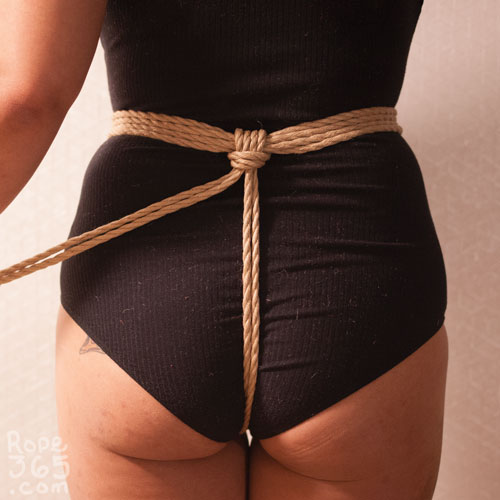 Crotch rope, aka matanawa 股縄 – Rope that goes between the legs. See
Crotch rope, aka matanawa 股縄 – Rope that goes between the legs. See
2025-07-22 at 1:51 PM
Good work, colleagues. I might not agree with every photo, but that’s probably for the next stage. My thanks to you.